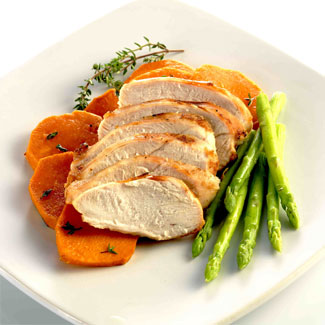Asparagus
 Imported asparagus may be available all year round but there is nothing to beat the treat of having locally grown asparagus in its short spring season, which traditionally begins on 23rd April and ends on Midsummer Day.
Imported asparagus may be available all year round but there is nothing to beat the treat of having locally grown asparagus in its short spring season, which traditionally begins on 23rd April and ends on Midsummer Day.
This feathery-foliaged herbaceous perennial grows to about 1 metre/3ft tall and takes several years to develop enough of the precious stems to allow harvesting; stems are picked when young and tender, before the buds begin to open as they soon become woody after that.
Asparagus is native to maritime areas and likes sandy soils which are quite salty (which acts as a natural weed suppressant). It requires space and the beds need to be left undisturbed for a number of years, so it is better suited to dedicated kitchen gardens than mixed domestic gardens, but the recent popularity of allotments (and interest in local foods and their production) has seen renewed interest and it is now being grown more widely again, with tomatoes as a companion plant. Although not often seen in shops yet, it is worth looking out for Irish grown asparagus at farmers’ markets.
Although its delicate flavour and seasonality makes it highly desirable in the kitchen, asparagus is much more than just a pretty vegetable. It has long been recognised for its medicinal qualities and is a good source of dietary fibre, protein and many vitamins, minerals, trace elements; low in calories and sodium, it has diuretic properties and is high in antioxidants.
So perhaps it is not surprising that the second century physician Galen is credited as describing asparagus as "cleansing and healing".
Green asparagus is widely grown and eaten, and white (blanched) asparagus is also very popular in northern Europe, where ‘asparagus menus’ are a speciality in restaurants in asparagus-growing areas.
Premium quality asparagus is best eaten steamed or semi-boiled (ie standing in a tall pan, with the lower stems in water and the tender upper section in steam), and served very simply as a starter with hollandaise, vinaigrette, melted butter or olive oil, Parmesan cheese or mayonnaise.
When plentiful and inexpensive, it makes a useful side vegetable and is a versatile ingredient for a wide range of dishes, from salads (used raw or cooked) and stir-fries to omelettes, risottos and barbecues.
RECIPE: Grilled Supreme of Chicken with Sweet Potato and Asparagus
 This dish was devised for a recent Happy Heart Eat Out campaign by Michael O’Meara, Oscars Bistro, Upper Dominick Street, Galway.
This dish was devised for a recent Happy Heart Eat Out campaign by Michael O’Meara, Oscars Bistro, Upper Dominick Street, Galway.
Serves 4
Click for recipe





There are currently no comments
Leave a comment
Not a member? Register for your free membership now!
Or leave a comment by logging in with: